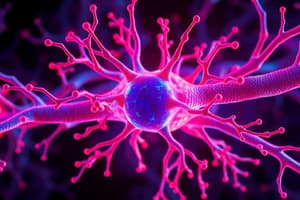Podcast
Questions and Answers
What is the primary role of tyrosine in the synthesis of noradrenaline?
What is the primary role of tyrosine in the synthesis of noradrenaline?
- It is converted to dopamine. (correct)
- It inhibits the release of neurotransmitters.
- It is stored in the vesicles.
- It stimulates α2 receptors.
Which drug mechanism primarily leads to the non-exocytosis release of norepinephrine?
Which drug mechanism primarily leads to the non-exocytosis release of norepinephrine?
- Excess calcium influx
- Amphetamine action (correct)
- Monoamine oxidase inhibition
- Direct receptor stimulation
What primarily regulates the release of noradrenaline?
What primarily regulates the release of noradrenaline?
- β receptor stimulation
- Reuptake mechanisms
- Catecholamine metabolism
- Auto-inhibitory feedback (correct)
In which type of uptake is norepinephrine removed more selectively from the presynaptic neuron?
In which type of uptake is norepinephrine removed more selectively from the presynaptic neuron?
What is a potential effect of α1 adrenergic receptors in the body?
What is a potential effect of α1 adrenergic receptors in the body?
What is the primary action of β1 adrenergic receptors when stimulated?
What is the primary action of β1 adrenergic receptors when stimulated?
What effect does stimulation of β2 adrenergic receptors have on the smooth muscles?
What effect does stimulation of β2 adrenergic receptors have on the smooth muscles?
What role do α2 adrenergic receptors play in neurotransmitter release?
What role do α2 adrenergic receptors play in neurotransmitter release?
What happens when an action potential reaches the nerve terminal?
What happens when an action potential reaches the nerve terminal?
What is the result of acetylcholinesterase action in the synaptic cleft?
What is the result of acetylcholinesterase action in the synaptic cleft?
Study Notes
Autonomic Medications - Adrenergic Transmission
- Synthesis of Noradrenaline (NA)
- Occurs in the axon of noradrenergic neurons.
- Tyrosine is converted to DOPA by tyrosine hydroxylase.
- DOPA is converted to dopamine by DOPA decarboxylase.
- Dopamine is converted to noradrenaline by dopamine hydroxylase.
- In the adrenal medulla, NA is converted to adrenaline by phenylethanolamine N-methyl transferase enzyme.
Storage and Release of NA
- NA is stored with ATP in vesicles.
- Two main release mechanisms:
- Exocytosis: Calcium influx into the presynaptic neuron triggers the release of NA into the synaptic cleft by exocytosis.
- Non-exocytosis: Certain drugs, such as amphetamines, can displace and release NA from the vesicles.
Noradrenaline Regulation
- Auto-inhibitory feedback mechanism:
- Released NA stimulates α2 receptors on the presynaptic neuron, inhibiting the release of further NA.
Elimination of Catecholamines
- Catecholamines (NA, adrenaline, isoprenaline) are eliminated by re-uptake and/or metabolic degradation.
- Re-uptake:
- Uptake 1 (presynaptic): NA is taken back into the presynaptic neuron.
- Uptake 2 (extraneuronal): NA is taken up by effector organs, such as the heart and smooth muscle, and is more selective for adrenaline.
- Metabolism:
- Monoamine oxidase (MAO): An enzyme found in mitochondria, particularly abundant in neurons.
- Catechol-O-methyl transferase (COMT): Found in various neuronal and non-neuronal tissues.
Adrenoceptor Classification
- Two main classes:
- α receptors (α1 and α2)
- β receptors (β1, β2, and β3)
Actions of Adrenergic Receptors
-
α1 receptors:
- Found in smooth muscle of various organs.
- Actions:
- Vasoconstriction : Constriction of blood vessels.
- Gastrointestinal (GI) relaxation: Relaxation of GI smooth muscle.
- Sphincter contraction: Contraction of all sphincters (GI and urinary).
- Mydriasis: Pupillary dilation due to contraction of the dilator pupillae muscle.
-
α2 receptors:
- Found in presynaptic neurons, CNS, and blood vessels.
- Actions:
- Inhibition of transmitter release: Inhibit release of neurotransmitters.
- Platelet aggregation: Promote platelet clumping.
- If found postsynaptically, they can function similarly to α1 receptors.
-
β1 receptors:
- Primarily found in the heart.
- Actions:
- Increased contractility: Strengthening of heart contractions.
- Increased heart rate: Faster heartbeat..
-
β2 receptors:
- Found in smooth muscle.
- Actions:
- Bronchodilation: Relaxation of the bronchioles, widening airways.
- Peripheral vasodilation: Relaxation of blood vessels in the periphery.
- Visceral smooth muscle relaxation: Relaxation of smooth muscle in internal organs.
- Skeletal muscle tremor: Muscle tremors.
- Increased aqueous humor secretion: Increased fluid production in the eye.
- Increased liver glycogenolysis: Breakdown of glycogen in the liver.
-
β3 receptors:
Adrenaline, Noradrenaline, and Isoprenaline Actions:
- Adrenaline, noradrenaline, and isoprenaline all activate both α and β receptors, but have different potencies.
- Noradrenaline: More potent at stimulating α receptors, less potent at stimulating β receptors.
- Isoprenaline: More potent at stimulating β receptors, less potent at stimulating α receptors.
Acetylcholine (ACh) Synthesis
- Choline transport: Choline is transported from the extracellular fluid into the cholinergic neuron's cytoplasm using an energy-dependent carrier system.
- Choline acetyl-transferase: This enzyme combines choline with acetyl coenzyme A (CoA) to form ACh.
- Choline properties: Choline is a quaternary amine with a permanent positive charge, preventing it from diffusing through the membrane.
Storage of ACh
- ACh is actively transported into presynaptic vesicles.
- Vesicle contents: Mature vesicles contain ACh, ATP, and proteoglycans.
- Vesamicol: This substance blocks ACh transport into synaptic vesicles.
Release of ACh
- Action potential arrival: An action potential reaching the nerve terminal opens voltage-gated calcium channels.
- Calcium influx: Increased intracellular calcium concentration triggers the fusion of vesicles with the cell membrane, releasing ACh into the synaptic space.
- Botulinum toxin: Blocks the release of ACh.
Degradation and Recycling of ACh
- Rapid signal termination: ACh is quickly broken down into choline and acetate in the synaptic cleft by acetylcholinesterase.
- Choline recycling: Choline is recaptured by a high-affinity uptake system, transporting it back into the neuron for the synthesis of new ACh.
ACh Receptors
- Two major classes of ACh receptors in the parasympathetic system:
- Nicotinic receptors
- Muscarinic receptors
Studying That Suits You
Use AI to generate personalized quizzes and flashcards to suit your learning preferences.
Related Documents
Description
Explore the intricate processes of adrenergic transmission in the autonomic nervous system. This quiz covers the synthesis, storage, release mechanisms, and regulation of noradrenaline, detailing how it impacts communication between neurons. Test your understanding of these critical biochemical processes.




